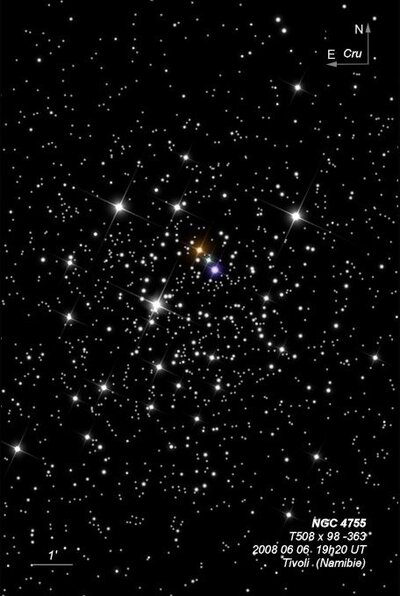Herschel's Jewel Box,kappa Crucis Cluster
Herschel's Jewel Box,kappa Crucis Cluster

10x30mm Canon IS (3/27/19 - Tasmania): the Jewel Box is bright naked-eye cluster close to Beta Crucis (Mimosa). Several very bright stars were resolved and some fainter stars using the 10x30 binoculars.
Nicolas-Louis de Lacaille discovered NGC 4755 = Lac II-12 = D 301 = h3435 in 1751 through a 1/2" telescope during his expedition to the Cape of Good Hope. He classified it as a nebulous star cluster and noted "5 or 6 small stars between two of sixth magnitude". It was probably next observed at the Parramatta Observatory during regular meridian work and described as "a cluster of 12 or 14 small stars, in the form of a rhomboid, very close together. Part of this cluster forms a very perfect cone of mixed stars." Using his 9-inch speculum reflector in 1826, James Dunlop described "(Kappa Crucis, Bode) is five stars of the 7th magnitude, forming a triangular figure, and a star of the 9th magnitude between the second and the third, with a multitude of very small stars on the south side - Figure 13 is a very correct representation."
John Herschel first observed the cluster on 14 Mar 1834 and recorded "the central star (extremely red) of a most vivid and beautiful cluster of from 50 to 100 stars. Among the larger there are one or two evidently greenish; south of the red star is one 13th mag, also red; and near it is one 12th mag, bluish." In preparation for his meticulous sketch of the cluster, he drew up a catalogue of 110 stars, accompanied by the following explanation: "Though set down by Lacaille as nebulous, and on that authority entered as a nebula in Bode's Catalogue, no nebula is perceptible in any part of the extent of this cluster, which though neither a large nor a rich one, is yet an extremely brilliant and beautiful object when viewed through an instrument of sufficient aperture to show distinctly the very different colour of its constituent stars, which give it the effect of a superb piece of fancy jewelery. The area occupied by it is about one-forty-eighth part of a square degree, within which area I have laid down, partly from micrometric measures (as regards the large stars) and partly from intertriangulation by the eye (as respects the small ones) the stars (110 in number) of the following catalogue." JH listed eight stars in which the "colour is conspicuous"; 3 are described as "greenish-white, 2 are green, 1 blue-green, 1 red and 1 ruddy.
In May 1862, English amateur astronomer and meteoroligist Francis Abbott constructed a map of 75 stars (from Hobart, Tasmania) five of which Abbott thought were not shown by Herschel. He commented "certain changes are apparently taking place in the number, position, and colours of its component stars." In 1872 Henry Chamberlain Russell, director of the Sydney Observatory, decided to investigate Abbott's claim and carefully measured the positions of the stars using the observatory's 7.25" refractor and creating a catalog of 130 stars. He mistakenly noted change also, as he thought several stars had changed their positions based on Herschel's sketch and several faint stars that Russell measured were surprisingly missed by JH. Russell later took perhaps the first photograph of the cluster in 1891. In 1929 Trumpler classified the cluster as type I 3 r -; "Detached, strong concentration, bright and faint stars in the cluster, rich in stars, without nebulosity."
300/350mm - 12" (6/29/02 - Bargo, Australia): the Jewel Box cluster is a beautiful, naked-eye cluster about a degree SE of Beta Crucis. At 186x, the cluster includes a half-dozen very bright stars (mag 6-7.5) set over a rich background of scores of mag 9-13 stars within a compact 10' diameter. A line of three mag 6-7 crosses the center of cluster from NW to SE with a striking orange-red variable star (DU Crucis = SAO 252073) near the center. Other stars have blue-white and yellow-whites tints, though these are more subdued. To the south of the cluster is the remarkable 6°x4° oval dark Coalsack which sits adjacent to the SE side of the Southern Cross.
Notes by Steve Gottlieb